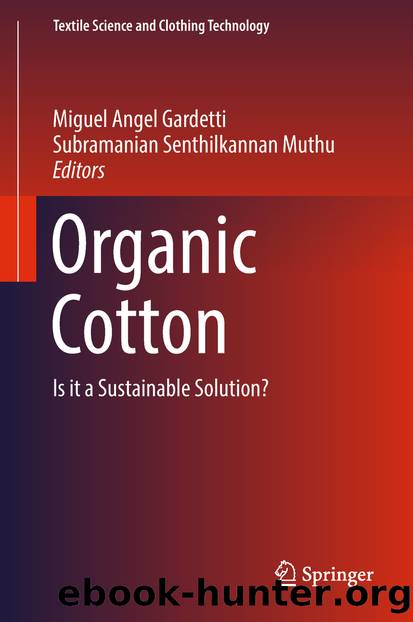Organic Cotton by Unknown

Author:Unknown
Language: eng
Format: epub
ISBN: 9789811087820
Publisher: Springer Singapore
2.1 Structure of the Naturally Colored Cotton
Recent investigations of naturally colored cottons have displayed that brown cotton is very similar in morphology to white cotton whereas green cotton is different as it comprises suberin. Suberin, contains mainly biofunctional fatty acids, can normally form a three dimensional network in the existence of glycerol that is found in green cotton fiber nevertheless not in white cotton fiber. Elesini et al. made a study for the confirmation of suberin in green cotton fiber by performing the infrared spectroscopy measurements. According to their results, it was concluded that; the bond (O6–H…O) that is normally found in cellulose I was not observed at the spectrum of green cotton. They also emphasized that the existence of suberin does not affect the structure of the individual crystallites nevertheless obstructs the development of the crystallites in the green cotton fibres [28].
Ahuja et al. investigated the performance of upland colored cotton germplasm. In 1995 and 1996 totally 18 F1 (Gossypium hirsutum) colored cotton hybrids were cultivated by crossing six white linted female lines F-505, LRK-516, F-846, HS-6, P-31 and LH-1134 with three colour linted male testers 84 (green linted), 2077 (medium brown linted) and H. Taskant (dark brown linted). The variance analysis results indicated that F1 colored cotton hybrids exhibited higher seed cotton yield, number of bolls/plant, fiber length, fiber strength and heavier bolls when compared with their parents. It was experimentally displayed that the pigments in naturally colored fibers were probably flavonoid compounds, such as flavonone, flavonol and anthocyanidin. It was concluded in this study that, color is controlled by a dominant gene (the genetic factor) and environmental factors which affect mainly the intensity of the color [28–30].
The investigations related to the comparison of the brown and green colored cotton structure with the white and brown cotton structure concluded that green cotton fibers have a different morphology from white and brown. This was explained with the green cotton’s secondary cell wall being composed of alternate cellulose-sub ring layers. Green cotton fibers are accepted as different from white fibers in terms of their smoother structure and containing higher organic solvent extractable material. Yatsu et al. carried out a research study where the green fibers (Gossypium hirsutum L.) were displayed by electron microscopy (EM) to possess numerous thin concentric rings around the lumen of the cell. EM investigation of both ordinary white and green cotton fibers exhibited that white cotton possesses a very thin (0.02 µm) outer cuticle while the green cotton displayed a series of concentric rings in the cell wall which was observed on the green cotton. Higher magnification of the osmiophilic ring structures of green cotton displayed that each ring consisted of a lamellar pattern characteristic of suberin while white cotton did not reveal any osmiophilic structure in the fiber walls. The cell wall in green cotton usually possesses numerous concentric, osmiophilic rings around the lumen of the cell [31].
When the cell wall of green cotton fiber was magnified, it was observed that the ring structure was
Download
This site does not store any files on its server. We only index and link to content provided by other sites. Please contact the content providers to delete copyright contents if any and email us, we'll remove relevant links or contents immediately.
POP by Steven Heller(2882)
Japanese Design by Patricia J. Graham(2554)
The Power of Broke by Daymond John(2376)
Architecture 101 by Nicole Bridge(2349)
Fusion 360 for Makers by Lydia Sloan Cline(1986)
Indistractable: How to Control Your Attention and Choose Your Life by Nir Eyal(1934)
Origami Art by Michael G. Lafosse & Richard L. Alexander(1733)
Batik by Rudolf Smend(1719)
Actionable Gamification: Beyond Points, Badges, and Leaderboards by Yu-kai Chou(1718)
Homebody by Joanna Gaines(1709)
Worn in New York by Emily Spivack(1617)
Feng Shui by Stephen Skinner(1616)
Whiskey in a Teacup by Reese Witherspoon(1574)
Austin Kleon by Steal Like an Artist(1535)
Don't Make Me Think, Revisited: A Common Sense Approach to Web Usability by Steve Krug(1525)
Simple Gatherings by Melissa Michaels(1510)
Hygge: The Danish Art of Happiness by Marie Tourell Søderberg(1426)
The Joy of Hygge by Jonny Jackson(1340)
The Laws of Simplicity by John Maeda(1299)
